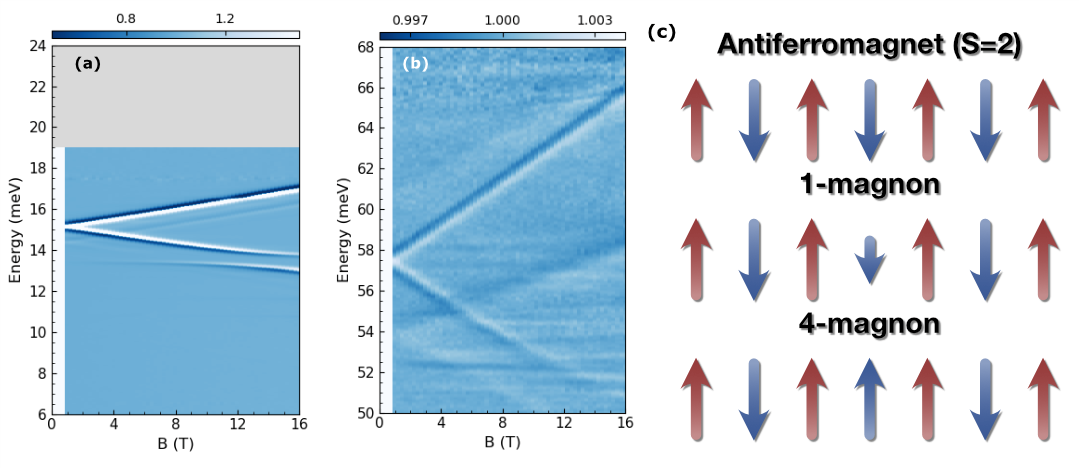Jan Wyzula and Milan Orlita, University of Fribourg and LNCMI Grenoble.
Magnons, or quantized spin waves, are collective magnetic excitations in solids. These boson-like quasiparticles disperse with lattice momentum k, carry a fixed energy, and possess an integer spin or angular momentum Sz = ±1. Although magnons are optically active, only spatially uniform spin waves can be excited due to the vanishing momentum of photons (k = 0 magnons). Despite their quantum nature, the optical and magneto-optical response of magnons can be approached semiclassically as transverse precession of coupled magnetic moments. In antiferromagnets, the associated resonant absorption of light is referred to as antiferromagnetic resonance (AFMR). AFMR has a particularly simple form in antiferromagnets with uniaxial anisotropy: a single mode that is also often referred to as one-magnon excitation. When the magnetic field is applied, this mode splits into two branches linear in B: ωAF = ωAF 0 ± γB, where γ stands for the gyromagnetic ratio. The branches are, thus, separated by twice the Larmor frequency, or equivalently, twice the Zeeman energy, 2Ez = 2gμBB, with the g-factor typically close to the free-electron value (g = 2). Such behavior was observed in a number of antiferromagnets. Recently, we performed AFMR experiments on the uniaxial antiferromagnet FePS3 in a collaboration of researchers from Grenoble, Fribourg, Prague, and Warsaw. This material belongs to a topical family of magnetic van-der-Waals systems and the magnetic order is, in this case, induced by largespin (S = 2) magnetic moments of iron Fe2+ ions that are arranged in a hexagonal lattice. Nevertheless, the observed AFMR response is more complex than expected. In addition to the conventional AFMR mode, or in other words, in addition to the one-magnon excitation (Figure 1a), another AFMR-like feature appears in the spectra. On a qualitative level, the additional mode resembles an AFMR. However, it displays a four-times larger splitting of the branches (Figure 1b). This excitation corresponds to a full reversal of a single spin S = 2 (Figure 1c), which carries a total angular momentum of |Sz| = 4. Our observation extends the concept of single-ion bound states, so far limited to two-magnon single-ion bound states in S = 1 systems, towards more complex excitations with multipolar symmetry. In particular, for S = 2 magnetic materials, their condensation in a magnetic field may allow for exotic hexadecapole phases. Overall, our findings illustrate the emergence of exotic quantum excitations in semiclassical magnetic materials with large spins.

Figure 1: Differential magneto-transmission spectra with onemagnon and four-magnon excitations, in (a) and (b), respectively.
(c) Schematic representation of a large-spin antiferromagnet with one-magnon and four-magnon excitations.
High-Angular Momentum Excitations in Collinear Antiferromagnet FePS3, J. Wyzula, I. Mohelský, D. Václavková, P. Kapuscinski, M. Veis, C. Faugeras, M. Potemski, M. E. Zhitomirsky, and M. Orlita, Nano Lett. 22, 9741 (2022).
https://pubs.acs.org/doi/10.1021/acs.nanolett.2c04111
Contact: jan.wyzula@unifr.ch, milan.orlita@lncmi.cnrs.fr






